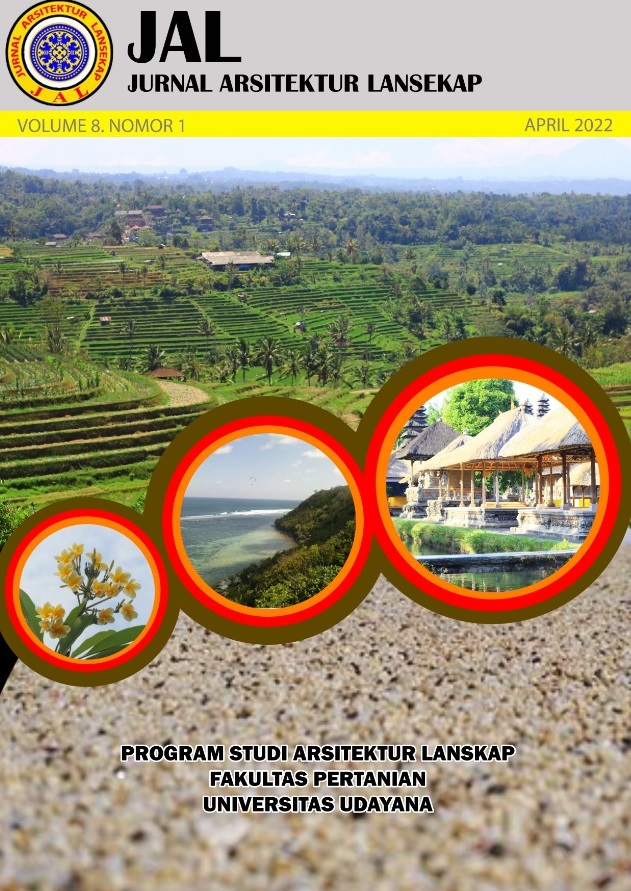Evaluasi Fungsi dan Kenyamanan Traffic Island Dewa Ruci pada Jalan Bypass Ngurah Rai di Kabupaten Badung
Abstract
Evaluation of Function and Comfortability of Dewa Ruci Traffic Island on Bypass Ngurah Rai Street in Badung Regency. The traffic island is part of an elevated crossroads with curbstone. The main function of the traffic island is as a traffic control and pedestrian safety when crossing. Aesthetically, traffic island has additional function as a landmark and beautification. The Dewa Ruci's traffic island (TIDR) in Badung Regency recently was redesigned for more attractive aesthetical city purpose that has caused activity and traffic violations. Thus, it is necessary to evaluate its function and comfort. The research method used was a survey method with data collection techniques through observation, site documentation, interviews related parties, questionnaires, and literature study. The analysis results showed that the primary function of TIDR which were for traffic control and pedestrian safety were 74,3% and 62,3%, respectively. Its illegal function which was a park area has the highest value (87%). This result also found there were three comfort variables which was low; circulation (50,9%), safety (59,7%), and thermal. Maintenance and management improvement, safety street furniture addition, and rearrangement of pedestrian paths in TIDR were recommended to improve the TIDR comfort.
Downloads
References
Institute for Transportation Development Policy. (2019). Panduan Desain Fasilitas Pejalan Kaki: DKI Jakarta 2017 – 2022 Volume 2. Institute for Transportation Development Policy. Jakarta. Hal 10 – 35. https://itdp-indonesia.org/publication/panduan-desain-fasilitas-pejalan-kaki-dki-jakarta-2017-2022/.
Kemenhub (Kementerian Perhubungan). (2018). Peraturan Menteri Perhubungan Nomor PM 82 Tahun 2018 tentang Alat Pengendali dan Pengamanan Pengguna Jalan. Menteri Perhubungan. Jakarta.
Kemenpu (Kementerian Pekerjaan Umum). (1996). Tata Cara Perencanaan Teknik Lansekap Jalan Nomor 033/T/BM/1996. Menteri Pekerjaan Umum. Jakarta.
Kemenpu (Kementerian Pekerjaan Umum). (2008). Peraturan Menteri Pekerjaan Umum Nomor 5 Tahun 2008 tentang Pedoman Penyediaan dan Pemanfaatan Ruang Terbuka Hijau di Kawasan Perkotaan. Menteri Pekerjaan Umum. Jakarta.
Kemenpu (Kementerian Pekerjaan Umum). (2012). Peraturan Menteri Pekerjaan Umum Nomor 5 Tahun 2012 tentang Pedoman Penanaman Pohon pada Sistem Jaringan Jalan. Menteri Pekerjaan Umum. Jakarta.
Nazir, M. (2005). Metode Penelitian. Ghalia Indonesia. Bogor.
Niewolt, S.(1998).Tropical Climatology, An Introduction to the Climates of the Low Latitude. John Wiley and Sons. New York.
Pemda Kabupaten Badung. (1996). Landmark Persimpangan Jalan Arteri Nusa Dua - Tanah Lot. Dinas Kebersihan dan Pertamanan. Denpasar.
Roscoe, J. T. (1975). Fundamental Research Statistics for the Behavioral Sciences. Holt, Rinehart and Winston. New York.
Sudjana, D. (2001). Metode Statistika. Tarsito. Bandung.
Yücel, G. F. (2013). We are IntechOpen, the world’s leading publisher of Open Access books Built by scientists, for scientists. Street Furniture and Amenities: Designing the User-Oriented Urban Landscape. Intech 23: 623 - 641. http://dx.doi.org/10.5772/55770.

This work is licensed under a Creative Commons Attribution-ShareAlike 4.0 International License.
An author who publishes in the Jurnal Arsitektur Lansekap (JAL) agrees to the following terms:
- Author retains the copyright and grants the journal the right of first publication of the work simultaneously licensed under the Creative Commons Attribution-ShareAlike 4.0 License that allows others to share the work with an acknowledgement of the work's authorship and initial publication in this journal
- Author is able to enter into separate, additional contractual arrangements for the non-exclusive distribution of the journal's published version of the work (e.g., post it to an institutional repository or publish it in a book) with the acknowledgement of its initial publication in this journal.
- Author is permitted and encouraged to post his/her work online (e.g., in institutional repositories or on their website) prior to and during the submission process, as it can lead to productive exchanges, as well as earlier and greater citation of the published work (See The Effect of Open Access).
Read more about the Creative Commons Attribution-ShareAlike 4.0 Licence here: https://creativecommons.org/licenses/by-sa/4.0/.







